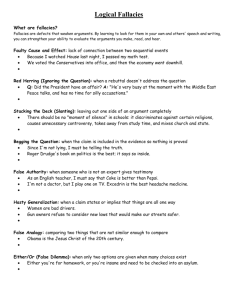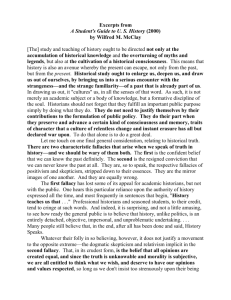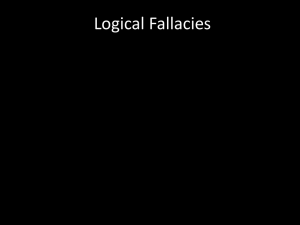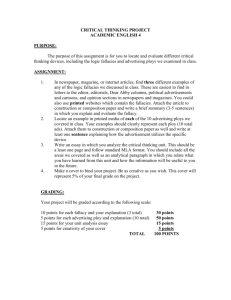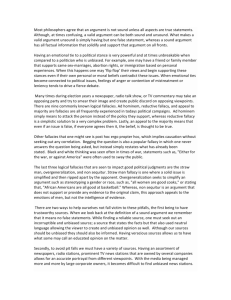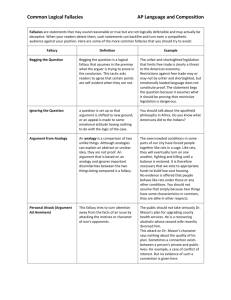Fallacies
advertisement
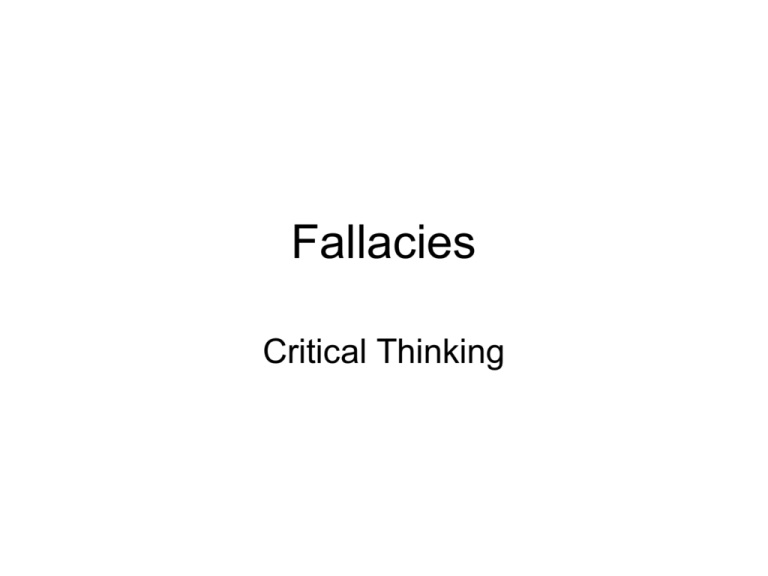
Fallacies Critical Thinking Fallacies • Fallacies are bad arguments that follow commonly used patterns (as many people think that they are good arguments). • One reason why there are so many fallacies is that many people use arguments to persuade other people, and to win debates, rather than to find the truth. • As someone said: “Arguments are to people as what lampposts are for drunks: they are used for support rather than illumination”. Do People Intentionally use Fallacies? • You may think that people intentionally use fallacies, i.e. use reasoning that they themselves realize is mistaken, but that they hope can persuade the audience. • This is not true: Almost anytime a fallacy is committed, the speaker is convinced that the argument is actually a good argument. • Of course, what may be going on is that the argument is seen as a good argument exactly because it is persuasive or, more importantly, is a ‘debate-winner’ (in other words, many people just don’t know what constitutes a good argument). • Indeed, many fallacies are committed when someone is going for the ‘quick kill’, i.e. at exactly those times when careful thinking and deliberation is no longer being used: killing the opponent often goes hand in hand with killing thinking completely! Fallacies of Relevance • One criterion of a good argument is that the premises should support the conclusion. • Fallacies that violate this criterion are Fallacies of Relevance: – – – – – Emotional Appeals Ad Hominem Fallacious Appeal to Authority Red Herring Appeal to Ignorance Appeal to Emotions (Fear, Pity, Vanity, etc) • Fear: – If you don’t believe in God, God sure won’t be happy about that! • Pity: – I deserve an A in the class because my mom was really sick and so I couldn’t concentrate • Vanity: – Intelligent people like yourself deserve [fill in any product here] Ad Hominem • The Ad Hominem Fallacy is committed when someone rejects a belief or argument based on its source. • Example: – I believe too many woman are too materialistic. When searching for a mate, their primary concern is often whether the guy has money – or at least more money than the other alternatives. This seems wrong to me! What do you think? – Barney I think you haven’t examined this fully. You call these women materialistic because they want men with money, but you don’t call the men materialistic for making money. It’s not as though these guys are doing well financially against their wills, you know! – Marilyn vos Savant Parade Magazine, September 10, 2000 Appeal to Authority • A Fallacious Appeal to Authority is committed when someone accepts a belief or argument based on an inappropriate appeal to authority. • Are such appeals ever appropriate? That’s a difficult question: it is true that such appeals never give any actual reasons. However, if we have reasons to believe that this authority knows what he/she is talking about, it may nevertheless be a good prudent reason to adopt that belief. • Inappropriate Authority: – According to my dad …[something about nuclear physics] – Einstein said … [something about evolution] • Unidentified Authority: – Studies show … – Experts agree … – Doctors recommend … • Appeal to the Masses: – Everybody knows … Red Herring • Sometimes the premises seem related to the conclusion, but they really aren’t: you are being led down the wrong path. • A red herring is a fallacy as it misses the point, and is talking about a different issue. • Sometimes, people intentionally use a red herring as a tactic of evasion (so it relates to: dodging, weaving, beating around the bush, tapdancing, though while these are all defensive tactics, the red herring is a bit more aggressive, in that it attempts to lead you astray) • Example: – I can't believe you thought that latest Disney movie was ok for children to watch. Disney pays 12-year old girls 31 cents an hour to sow their products together! Appeal to Ignorance • An appeal to ignorance is made when one argues that something is the case since no one has shown that it is not the case: – Smoking is ok, since no one has proven that it is bad for your health. – Our factory output shouldn’t be restricted for environmental reasons, since no one has shown that the green house effect really exists. • Often, appeals to ignorance involve a shift in the burden of proof: – Why do I believe that God exists? Well, can you prove that God does not exist? Invincible Ignorance • A special case of the appeal to ignorance is when the ignorance is seen as evidence of some view: – The fact that there is no known evidence of extra-terrestrial intelligent life actually supports my theory that the government is covering it all up! – Of course God doesn’t make himself visible. Such is the nature of God! • But the ignorance is of course not evidence if the opposite view would make the very same prediction: – If extra-terrestrial aliens have not been visiting us, there would be no evidence either – If there is no God, we wouldn’t see God either. • An additional problem with the views above is that they make the theories invincible, i.e. irrefutable. That sounds good on the surface of it, but it logically also means that we can’t provide any evidence for these views either. So, the complete opposite view would be just as plausible. Non Sequitor • A non sequitor is simply any fallacy of relevance (it is Latin for “doesn’t follow”). • If some argument contains a fallacy of relevance, but it doesn’t fit any of the types discussed before, you can call it a fallacy of relevance or, if you want to sound impressive, a non sequitor. Fallacies of Assumption • A second criterion of a good argument is that the premises should be plausible. • A Fallacy of Assumption violates this second criterion – False Dilemma • Perfectionist Fallacy • Line-Drawing Fallacy – Straw Man – Slippery Slope – Begging the Question False Dilemma • An argument assumes a false dilemma when it assumes that one of two cases must be true, where in fact there are other options as well. Examples: – Since you’re not a capitalist, you must be a communist! – You’re either with us, or against us. – Are you a Democrat or a Republican? – Nature or nurture? Perfectionist Fallacy • The perfectionist fallacy presents us with a kind of ‘all or nothing’ false dilemma: – We shouldn’t give aid to countries where people are starving, because we can’t eradicate hunger completely. • The perfectionist fallacy often works very well in combination with an inconsistency ad hominem: – You want us to be vegetarians, and yet you are still wearing leather shoes?! Line-Drawing Fallacy • Another kind of false dilemma: Either we can draw a precise line between two things, or there is no difference between the two at all: – Abortion is murder from the moment of conception, since we can’t point to any exact moment in time before which the fetus is not a person, and after which the fetus is. • The fallacy is this: just because no precise lines can be drawn doesn’t mean that there are no distinctions. E.g. if you go through the color spectrum from red to blue, is there a clear point at which you can say: “Ah, that’s where it stopped being red!”. No. But this doesn’t mean that there is no distinction between red and blue. • As a matter of fact, most of our concepts are fuzzy and have vague boundaries, but that doesn’t mean that we can’t make useful distinctions. For example, biologists can’t agree on a definition of ‘life’, but at the same time it is clear that dogs are alive, and rocks are not. Black and White Thinking • The False Dilemma Fallacy can be seen as the result of black and white thinking: a failure to appreciate that sometimes (in fact, quite often) things are more complicated, complex, subtle, vague, dirty, messy, and gray than we (would like to) think they are (especially the perfectionist and the line-drawing fallacy exhibit this). • Black and white thinking also expresses itself in the way we argue: we often think that there are ‘two sides to an issue’, and many of the rhetorical strategies are meant to elicit a simple ‘Yay’ or ‘Boo’. • Indeed, we often see the people in the world as belonging to two groups: ‘us’ and ‘them’. This ‘partisan mindset’ is particularly inconducive to any kind of rational and critical thinking. Straw Man • A Straw Man argument attacks something by attacking a helpless caricature of that something: it often distorts the original by exaggeration. Example: – The movement to allow prayer in public school classrooms is a major threat to our freedom. The advocates of prayer in school want to require every school child to participate in a Christian religious program prior to every school day. Slippery Slope • A slippery slope fallacy makes a dubious assumption that one thing will lead to another – If the “experts” decide today that we should have fluorides in our tea, coffee, frozen orange juice, lemonade, and every cell of our bodies, what’s next? Tranquilizers to avoid civil disorders? What about birth-control chemicals to be routed to the water in certain ethnic neighborhoods? Begging the Question • Circular reasoning: – God exists because the bible says so. … What, why we can trust what the Bible says? Easy, the Bible is the word of God. • Restating the conclusion: – Communism won’t succeed, since a system where everything is owned in common won’t work. • The “True Scotsman” Fallacy: – All Germans like sauerkraut. … Oh, your brother-in-law is German and he doesn’t like sauerkraut? Well, he is not a true German then, is he? Fallacy of Missing Evidence • A third criterion of a good argument is that all relevant information (as far as we are aware of it of course!) is taken into account. • The fallacy of missing evidence is where this criterion is not satisfied • Depending on how intentional the missing information came to be missing, some other labels for this are: – – – – Neglected evidence Selective evidence Cherry-picking / Hand-picking Suppressed evidence The One Big Ethical Fallacy • Ought From Is! – Since it is so, it ought to be so. – “Well, that’s how we should behave, because everyone behaves that way!” • Subclasses: – Naturalistic Fallacy: “It’s natural, so it’s good” – Normalistic Fallacy: “It’s normal, so it’s good” – Traditionalistic Fallacy: “It’s always been that way, so it’s good” And Now, Two Warnings! Once you Have a Hammer, Everything Becomes a Nail • You can see many fallacies around you all the time once you recognize these patterns. • In fact, I have found that many beginning critical thinkers now suddenly start to see fallacies where there aren’t any: it just looks like a fallacy! • This is sometimes called the ‘Fallacy Fallacy’ Don’t throw out the Baby with the Bath Water! • Similarly, many beginning critical thinkers will dismiss whole arguments once they spot fallacious thinking (or emotional appeals or rhetorical tactics), when in fact this may only be a small problem, or a problem that occurs in a relatively unimportant part of the argument. • Remember, your goal as a critical thinker is to find truth. Hence, you should always try and see ‘through’ the rhetoric and other fallacious tactics and see if there isn’t still something important that the speaker is trying to communicate.


